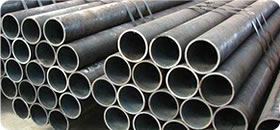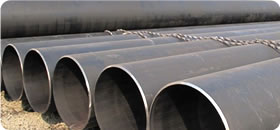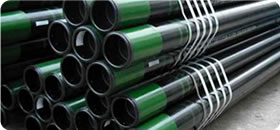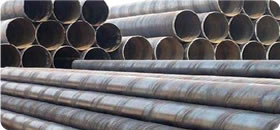Manufacturing process of straight seam steel pipe
There is a support at the back side to thread the blanking pipe section into the roller, and there is a brand frame at the back side to fix the roller. There is an electric wheel in the middle. Some of the electric wheels are driven by hydraulic drive, and some are driven by mechanical drive, that is, lead screw drive, and then the electric wheel is rolled forward. The electric wheel rolls the pipe and moves forward along the roller. There is an induction ring outside the roller to heat the pipe and heat it up. Then the electric wheel rolls the pipe down and processes one. After rolling, the straight seam steel pipe shall be flattened in this hot state. Because some straight seam pipes will be twisted after improper treatment, which is not allowed.
After rolling, the outer diameter of the head is generally large, and it needs to be flattened through the flat die. The flat die is actually a press, and there should be a set of dies, two semicircles, one at the top and one at the bottom. The flattened outer diameter meets the size requirements of the finished product. The interlayer is controlled by the interlayer of the raw material. The interlayer tolerance of straight seam pipe and pipe is the same, which is ± 22.6%. In the process of rolling, the interlayer should not change under normal circumstances, but if the wall reduction occurs in some places due to tool reasons, so some allowance should be added to the interlayer when the material is generally lifted. For example, the straight seam tube is 8.28 mm interlayer, and the tube is generally raised about 8.6 mm, to prevent over-tolerance due to local thickness reduction during rolling. After shaping, the outer diameter and interlayer size of the straight seam pipe meet the requirements.
Next, the finishing process will be carried out. After shot peening, the corrosion rust on the inner and outer layers of the straight seam pipe will be removed, and the two ends will be beveled for welding. After screening, spray printing, anticorrosive paint, forming and other processes, it can leave the factory. The above is the manufacturing method of straight seam pipe with straight seam steel pipe as raw material under 31 ″, and the maximum straight seam pipe is between 2.042 meters and 2.80 meters, which is made of steel plate after exceeding 31 ″, i.e. more than 600 mm. After the steel plate is cut into materials according to the requirements, it is shaped like tyc, and it is also punched into a circle through a die. The two halves are then assembled and welded. Non-destructive testing shall be conducted due to the existence of welds. Due to the existence of welding stress, heat treatment is also required. There are two more processes for welding straight seam steel pipes: one is flaw detection and the other is heat treatment. The other procedures are the same.
previous_pageHow to solve the magnetic problem of thick wall spiral steel pipe?
next_pageLast page




